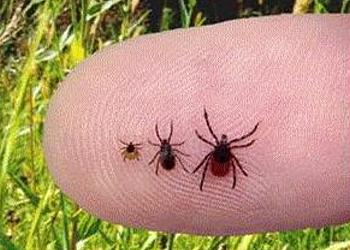Last weekend, like many families, we wanted to have a family day out somewhere green in the sunshine. The boys wanted to take various sporting goods (football, cricket bat etc) so a trip to Kew Gardens was out. Instead, we decided to go to Bushy Park, the second largest Royal Park in London near Twickenham. M&S provided sausage rolls and crisps, the kids chased balls, my husband had a snooze and I even got to read a bit of the paper uninterrupted – and we saw some deer roaming wild. All good.
The next evening, my youngest son gave a yell from the bathroom “Mum, there’s an insect IN my leg”. By the time I got there, he proudly showed me a little creature on his finger and a red hole on his upper thigh from where he had dug it out, surrounded by a round red patch on the skin about 10cm in diameter. Being an inquisitive sort of family, we stuck on some Savlon and then put the bug under the microscope and worked out it was a tick. A tiny one, no bigger than a big pinhead with legs. (If my web skills were better I’d post a picture but that’s for another day.)
Now I’m a healthcare professional and I know from my training that where there are deer there is a danger of tick bites, and that they can carry a range of nasties including something called Lyme Disease which affects the joints. So I did some research, and took my son to the GP who prescribed antibiotics just in case he picked something up. Hopefully that’s the end of the matter. But in my reading I learnt a lot and thought I’d share it with you.
Note that the treatment and diagnosis of Lyme Disease (LD) isn’t black and white, the treatment protocols are not fully researched and ticks in different countries carry different strains of the bacteria, causing different symptoms. There is a lot left to learn but this is what I picked up:
What is Lyme Disease ? A blood-borne bacterial infection (mainly Borrelia Burgdoferi) carried by ticks (tiny arachnids), which live on deer. It was named for Old Lyme, Connecticut, USA but is not a new disease.
Where can you catch it ? The Northern Hemisphere – many countries in the US and Northern Europe as well as Asia. For West-Londoners, Richmond and Bushy Parks are homes to the ticks, with LD definitely in Richmond and possibly Bushy too according to a small study in 2013 by the London School of Tropical Medicine. The New Forest, South Downs and other UK sites all have infected ticks. Between March-October is the most likely time to catch it as the ticks are reproducing, but thankfully not all ticks carry the disease (in fact only a small proportion). The NHS estimate that 2-3,000 people are infected every year, but other experts suggest this is an underestimate. So you probably WON’T be bitten, and if you are, the chances are that the tick WON’T have LD, but just in case, forewarned is forearmed etc. . .
What are the symptoms ? Following infection, it can take between 3-30 days to display symptoms, and some people don’t at all. As it is a bacterial infection, the effects can be widespread. The most often quoted symptom is a “bullseye rash” (see picture) but this only appears in 1 in 3 cases according to the NHS. Other symptoms include flu-like symptoms, joint pain, neurological pain, behavioural changes and facial pain amongst others. Very acute cases are thankfully rare but have serious symptoms.
Untreated, the disease can become chronic and cause severe widespread problems including arthritis and organ damage (heart, kidneys) or fatigue-type problems. You may have seen the press surrounding the cases of the Phones4U founder John Caudwell and his family. Such symptoms appear to be rare, but awareness, early detection and treatment is a good idea and advocated by lots of healthcare organisations.
How is it diagnosed ? This isn’t straightforward. There IS a blood test for LD but it is not always accurate, and a diagnosis is usually ‘clinical’ – which means the physician diagnoses based on symptoms, exposure and the whole picture. Not all UK professionals are aware of LD which makes it a bit more difficult but awareness is growing. A new NICE Consultation is in progress which will update the UK protocol.
LD is prevalent in the Nordic countries and a friend and her son recently contracted LD on holiday. Neither had the ‘bullseye rash’ . They were not diagnosed until 2 months later back in the UK, by which time the boy was acting differently – ‘totally hypersensitive behaviour’, had a super sensitive scalp and couldn’t sleep well. The parents recognised LD but it took several visits to UK medical professionals to move forward. They visited a private walk-in centre for blood tests and this confirmed the diagnosis.
How is it treated ? It is thought that removing ticks quickly (less than 24 hours) reduces the chance of infection. Several weeks of antibiotics are required to kill the bacteria. For chronic cases it is more a case of managing symptoms.
Talk to your GP about your concerns. Some websites suggest that you only need antibiotics if the ‘bullseye’ rash develops, but this only happens in the minority of cases, so you may need them anyway. A blood test may not be positive for a few weeks so it’s not always useful to wait till then.
What do you do if you think you have been bitten or if you suspect a bite:
- Ticks are TINY. Ours was the smallest of the life-stage photo shown here.
- If you find a tick, remove it with tweezers without twisting or crushing. Try and get it all out, wash and put antiseptic cream on.
- If you find a rash, see your GP. If you are concerned about a bite, see your GP. The NHS website (below) says “See your GP if you suspect you have been bitten (even without a rash, my addition) and tell them you have been in woodland or areas know to be infected”.
- Go armed with some information about Lyme Disease. My GP who is very sensible, didn’t know much, despite our living near infected parks. My Pharmacist knew a bit more.
- Keep a record of any rashes, flu-like symptoms, joint pains or neurological changes (pain, mood etc).
How can you prevent tick bites ?
- Wear long trousers and long sleeves in areas that are known to be infected (not easy on a hot day!).
- Avoid long grass and stick to the paths
- Use insect repellent
- Inspect yourself & your children really well after a trip somewhere where it is prevalent. Note that the ticks can climb up inside clothing, so look at skin creases, the hairline and other hidden areas.
- The chances of infection are less within 24 hours of being bitten, so check soon…
- Remember to check your dogs too.
There are some good websites out there for more information. Note that there are different strains of Lyme Disease around the world and so country-specific sites may not have the relevant details of symptoms or treatment. Try these sites:
https://www.gov.uk/government/uploads/system/uploads/attachment_data/file/521829/Ticksandyourhealthinfoabouttickbites.pdf Excellent UK fact-sheet.
www.lymediseaseaction.org.uk UK based action group.
http://www.nhs.uk/Conditions/Lyme-disease/Pages/Introduction.aspx
www.cdc.gov/lyme US site with useful overall information.
I hope this has been useful, any errors are mine – check with your GP or other health professional if you are concerned about symptoms or exposure.
Anji is a Registered Osteopath and Yoga Teacher based in Ealing, London.

